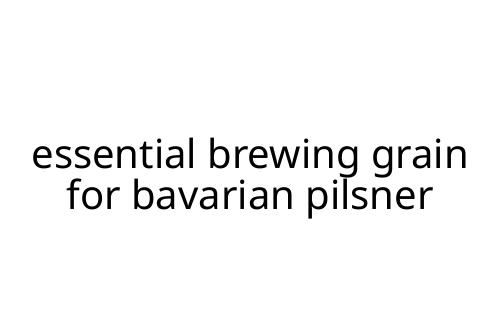essential brewing grain for bavarian pilsner
Bavarian pilsner is defined by its crisp, clean flavor and brilliant clarity. One ingredient has the biggest impact on those qualities: the essential brewing grain for Bavarian pilsner is pilsner malt. If you want to brew a true Bavarian pilsner at home or simply want to understand what sets it apart from other lagers, learning about this key grain is a good starting point.
What Makes Pilsner Malt Essential
Pilsner malt is a lightly kilned, pale malt made primarily from two-row spring barley. Its gentle malting process preserves a delicate, bready flavor and high enzymatic potential. In Bavarian pilsners, this grain creates a light golden color and a soft malt character that’s clean but present.
Unlike standard pale malts, pilsner malt is less kilned, so it delivers subtle grain sweetness and none of the caramel notes found in darker malts. This is what gives Bavarian pilsner its signature taste—balanced, dry, and never heavy.
Supporting Grains: Should You Use Them?
While pilsner malt is the foundation, some brewers add small amounts of other grains—like Munich malt or Vienna malt—for complexity. However, traditional recipes use only pilsner malt. It’s rare to see much else in classic Bavarian examples.
Adding specialty grains can introduce unwanted flavors or darken the beer, nudging it away from the crisp and bright profile typical of the style. The best advice? Keep it simple. Let the pilsner malt shine.
Water and Hops Matter, Too
It’s hard to talk about essential brewing grain for Bavarian pilsner without touching on water and hops. Bavarian brewers traditionally use soft water, low in minerals, which highlights the malt's gentle flavor. For hops, noble varieties like Hallertau or Tettnang add floral, spicy bitterness but never overshadow the grain.
Pros and Cons of Ingredient Simplicity
Pros:
- Clean, focused malt flavor
- Easier to identify flaws and improve your brewing process
- Consistent results
Cons:
- Minimal room to hide brewing mistakes
- Less flexibility for creative flavors
If you use high quality pilsner malt and precise technique, the payoff is a bright, authentic Bavarian pilsner with unmistakable malt backbone.
Practical Tips for Homebrewers
- Choose fresh pilsner malt from a trusted supplier. Old grain loses its delicate aroma.
- Consider a step mash if you want to emulate Bavarian tradition. This can enhance fermentability and head retention.
- Watch your boil: Pilsner malt is prone to developing DMS (a cooked-corn off-flavor) if the boil isn’t vigorous and long enough (at least 90 minutes recommended).
Final Thoughts
At the end of the day, the essential brewing grain for Bavarian pilsner will always be high-quality pilsner malt. Treat it with care, complement it with soft water and noble hops, and you’ll have a beer that honors its German roots—clean, drinkable, and all about the malt. Simplicity, in this case, isn’t limiting. It’s what sets this classic style apart.

 Keshian Bakerstell is a talented article writer and a unique voice at Your Local Insight Journal. Her writing brings a fresh perspective to the platform, capturing the essence of the Lansing, MI community with insight and creativity.
Keshian Bakerstell is a talented article writer and a unique voice at Your Local Insight Journal. Her writing brings a fresh perspective to the platform, capturing the essence of the Lansing, MI community with insight and creativity.
